Seven Common Communicable Diseases in Africa: Causes and Control
By: Moses Odey, DLHA Volunteer and Freelance Health Writer, with editorial support from the DLHA Team
Africa faces more health challenges than any other region of the world. Studies have identified seven major conditions as the leading causes of infectious or communicable illness and death in Africa.
The World Health Organization (WHO) reported that these communicable diseases were responsible for substantial years lost in Africans due to ill health or disability that was estimated at 704,765,879 Disability Adjusted Life Years (DALYs) in 2015 alone.
The drivers of the burden of these conditions in Africa are many, including;
This article will focus on these seven common communicable diseases in Africa, with emphasis on their respective causes and public health control.
The diagnosis, symptoms and treatment of each of the diseases will be the subject of future separate articles.
Malaria is a life threatening fever-inducing illness transmitted through the bite of an infected female Anopheles mosquito.
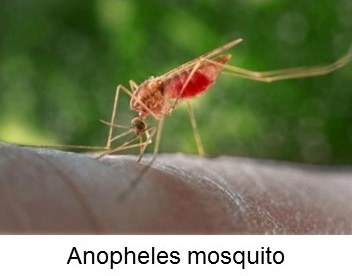 Infected female mosquitoes carry the plasmodium parasite in their saliva and when these mosquitoes bites you, the plasmodium parasite enters into your bloodstream.
Infected female mosquitoes carry the plasmodium parasite in their saliva and when these mosquitoes bites you, the plasmodium parasite enters into your bloodstream.
Once the parasites enter the bloodstream, they travel to the liver where they mature, reproduce and get released into the blood stream to start the infection.
These parasites also infect and destroy the red blood cells of the human person. Malaria is especially dangerous for children especially those below the age of five, the elderly, and also pregnant women.
According to a World Health Organization (WHO) report, the African region carries a high share of the malaria burden. In 2021, there were 241 million reported cases of malaria worldwide with a total of 619,000 deaths.
As at 2023, estimated malaria cases stood at 263 million globally compared to 252 million cases in 2022. The estimated number of malaria deaths stood at 597 000 in 2023 compared to 600 000 in 2022.
Also in 2023, the African region accounted for 95% of these malaria cases and 96% of these malaria deaths worldwide. Children under the age of five also accounted for about 76% of all malaria deaths in Africa.
In sub-Saharan Africa (SSA), the following four countries in the region account for nearly half of all malaria deaths worldwide in 2021:
Although there are many Plasmodium species, only five of these species cause malaria in humans.
These are:
The plasmodium falciparum and vivax are considered to be the most deadly of these parasites. Nearly all cases of malaria in SSA are caused by plasmodium falciparum parasites. These parasite are also the commonest cause of malaria in South East Asia, Eastern Mediterranean and Western Pacific regions. Comparatively. the plasmodium vivax parasites cause 75% of malaria cases in the WHO region of the Americas (AMR).
The plasmodium knowlesi however rarely occurs in humans and is not transmitted by mosquitoes but by infected monkeys.
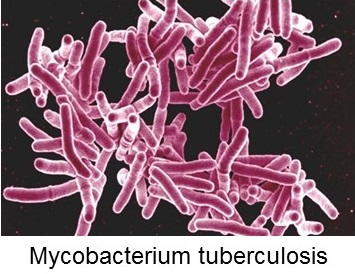
Tuberculosis commonly known as TB is one of the oldest and most common infectious disease in Africa.
Tuberculosis is an airborne disease and is transmitted when a person infected with active tuberculosis coughs, sneezes, sings, or spits into the air and another individual inhales the air which contains the bacteria. Tuberculosis usually affects the lungs and in this case is known as pulmonary tuberculosis.
Pulmonary tuberculosis which affects only the lungs is the most common form of tuberculosis known.
"Tuberculosis can affect other part of the body such as the spine, the abdomen, the brain, the heart, the spine, the kidney, the skin. But many people do not know this. The types of tuberculosis which affects other parts of the body, is known as extrapulmonary tuberculosis,” says Dr. Inaku Paul, Medical Officer University of Calabar Medical Center.
Those who have latent tuberculosis do not develop symptoms and do not spread the disease. However, people with active tuberculosis usually develop symptoms and also spread the disease.
According to the World Health Organization (WHO) report, in 2016, 2.5 million people fell ill with tuberculosis in the African region, accounting for a quarter of new tuberculosis cases worldwide. In the same year, about 417,000 people died of tuberculosis in the African region from a total number of 1.7 million people globally.
Tuberculosis usually but not always exist as a co-infection with HIV/AIDS. Therefore, people with HIV/AIDS are most likely to develop an active tuberculosis Infection. Those who smoke also have a high risk of developing an active tuberculosis infection.
Tuberculosis is an infectious disease caused by a bacterium called Mycobacterium tuberculosis bacteria (MTB).
The TB bacteria usually attack the lungs, but additional parts of the body such as the kidney, spine, and brain can also be attacked. Not everyone infected with TB bacteria becomes sick.
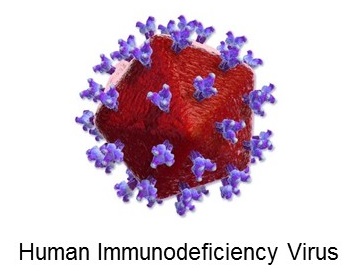 Key facts
Key facts
According to the World Health Organization (WHO), the Human Immunodeficiency Virus (HIV) is an infection that attacks the body’s immune system especially the white blood cells called CD4 or T cells.
The virus destroys these CD4 cells thereby weakening the immune system’s ability to fight against infections and diseases and also makes the immune system vulnerable to opportunistic infections such as tuberculosis, fungal and severe bacterial infections and some cancers.
Acquired Immunodeficiency Syndrome (AIDS) is the last and most severe stage of HIV and occurs when a person’s immune system has been severely damaged. It is associated with the development of certain cancers, infections or other severe long-term clinical manifestations.
You can get HIV through direct contact with different body fluids like:
Contact with the virus commonly occurs through:
According to the World Health Organization (WHO) regional report, the African region is the most affected region with HIV with about 25.7 million people living with HIV out of a global total of 37.9 million in 2018.
The African Region also accounts for almost two thirds of the global total of new HIV infections. In 2018, about 1.1 million people were infected with HIV in the Africa region. And in 2016, roughly 24,000 children died of AIDS related cases in Nigeria.
HIV is caused by a virus which attacks the white blood cells called CD4 cells which is the body’s defense against illness. HIV destroys these CD4 cells in the body and replicates itself insides these cells and in that way, weakens the body’s Immune system making it vulnerable to infections and other opportunistic diseases.
AIDS is the last and most severe stage of an HIV infection with very severe damage of the immune system.
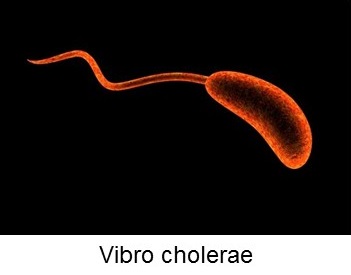 Key facts
Key facts
Cholera is an acute diarrhea infection of the small intestine caused by the ingestion of food or water contaminated with the bacterium Vibrio cholerae.
Majority of people with cholera infection develop mild or moderate symptoms while only a minority develop acute diarrhea with severe dehydration that can lead to death within hours if left untreated.
“One can hardly find cholera in developed or urban areas because there is good water and food hygiene, and proper sanitation”, says Dr. Adah, Senior Medical Officer University of Calabar Medical Center.
Most people infected with cholera do not show any symptoms although the bacteria are present in their faeces for 1-10 ten days after infection.
It has been estimated that there are 1.3 to 4.0 million cases of cholera, and 21,000 to 143,000 deaths worldwide due to cholera each year. The highest burden of the infection occurs in Sub-Saharan Africa.
Children and those with HIV/AIDS bear the highest risk of the disease as well as the highest death rate.
People with blood type O who contract cholera have been reported to present with severe infection.
The risk of death among cholera patients can be as low as 5% and as high as 50%. Lack of immediate access to treatment results in higher death rates.
Cholera occurs as both sporadic outbreaks as well as chronically in most countries of Africa.
Example of African countries with reported irregular outbreaks as well as chronic occurrence of cholera include, Nigeria, Liberia, Kenya, Tanzania, Democratic Republic of the Congo, South Sudan and others.
Research has shown that the proportion of people who die from reported cholera remains higher in Africa than anywhere else in the world. The Sub-Saharan Africa been the region with the highest number of cholera cases and deaths.
Cholera is a bacterial infection caused by the bacterium vibrio cholerae which is ingested into the body through food or water contaminated with the bacteria. Cholera causes severe diarrhea, dehydration, and electrolyte imbalance, and could lead to death within hours if left untreated.
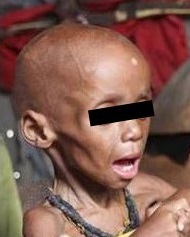 Key facts
Key facts
Diarrhea is the condition wherein frequent passage of loose, watery stool occurs.
The World Health Organization (WHO) defines diarrhea as the passage of three or more loose or watery stools per day (or more frequent passage than is normal for the individual).
Frequent passing of formed stools is not diarrhea, nor is the passing of loose, “pasty” stools by breastfed babies.
In Africa, studies have shown that diarrhea numbers among one of the leading causes of death in children under the age of five.
Different studies showed that the prevalence of diarrhea diseases among children under five years is high in East African countries. This is due to the fact that in these countries as in most of SSA, access to basic sanitation and hygiene services is very low.
According to severity, the two clinical types of diarrhea are
Acute watery diarrhea lasts only a few days and heals on its own. It is usually caused by an infection which can be a virus, bacteria, or parasite. Certain medications can also cause this type of diarrhea. Acute diarrhea is most commonly due to viral gastroenteritis with rotavirus, and accounts for 40% of cases in children under five.
Acute bloody diarrhea is also referred to as dysentery. It may run a similar course as acute watery diarrhea. It is caused by a type of bacteria, called Shigella.
This type of diarrhea lasts for at least four weeks. Chronic diarrhea is caused by functional disorders such as:
Diarrhea is usually a symptom of an infection in the intestinal tract, which can be caused by a variety of bacterial, viral and parasitic organisms. Infection is spread through food, or water that has been contaminated by faeces, or from person to person as a result of poor hygiene and sanitation.
Infectious diarrhea is also referred to as gastroenteritis. Norovirus is the usual cause of viral diarrhea in adults while rotavirus is the common cause in children under five.
.jpg) Overview
OverviewLower respiratory tract infection (LRTI) is an infection of the lungs specifically in the lower air ways.
Lower respiratory tract infections are usually caused by tiny organisms such as viruses and bacteria. These infections are carried in tiny droplets and can be transmitted when an infected person coughs or sneezes.
It could also be transmitted through contact with surfaces carrying these viruses or bacteria.
Common lower respiratory tract infections are:
Pneumonia is an infection that causes inflammation of the air sacs in one or both of the lungs. The lungs are made up of small sacs called alveoli, which fill with air when a healthy person breathes. When an individual has pneumonia, the alveoli are filled with pus and fluid, thereby making breathing painful and limits oxygen intake. Pneumonia is usually caused by bacteria or viruses.
Tuberculosis
Tuberculosis is a contagious infection which affects the lungs although, it can spread to other parts of the body such as: the brain, the spine and the kidney.
Tuberculosis is caused by a bacterium called Mycobacterium tuberculosis and is transmitted through the air when an individual with an active tuberculosis infection coughs, sings, or spits into the atmosphere thereby discharging tiny droplets of the bacteria into the atmosphere. Another individual can breathe in the droplets and the bacteria find their way into the lungs.
Bronchitis is an Inflammation of the lining of the bronchial tubes which carries air to and from the lungs.
Bronchitis happens most of the time in older children and adults although it affects all ages and is caused by either a virus or bacteria.
Bronchiolitis is an inflammation of the small airways of the lungs. It causes the bronchioles to swell, making breathing difficult.
This illness is more common in infants and toddlers under two years and is usually caused by the respiratory syncytial virus (RSV), rhinovirus and the human metapneumovirus.
Studies have shown that lower respiratory tract infections are the leading causes of death in children below the age of five and half of those deaths occur in Africa.
Lower respiratory tract infections are usually caused by viruses and bacteria which affect the respiratory tract. Fungal infections and parasite which are neither viruses nor bacteria can also cause lower respiratory infections, but less commonly.
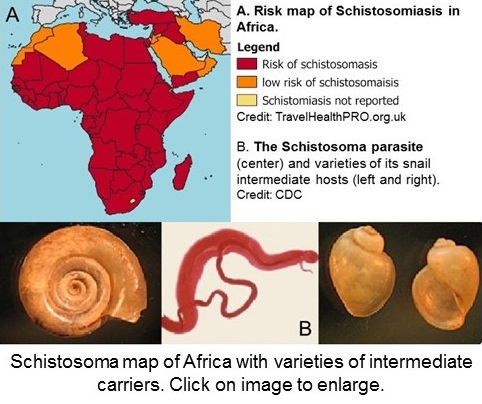 Key facts
Key facts
Schistosomiasis is a disease caused by small parasitic flatworms called schistosomes. Infection occurs when the larval forms of the parasite which is released by freshwater snails penetrate the skin during contact with infested water.
Schistosomiasis is transmitted when infected people contaminate freshwater sources with faeces or urine containing parasite eggs, which hatch in water.
There are two major forms of schistosomiasis
These two major forms of schistosomiasis are caused by five main species of blood fluke which are:
Schistosomiasis mostly affects poor and rural areas, agriculture and fishing populations.
Women who do domestic chores such as washing of clothes in infested water can develop female genital schistosomiasis. Children who play in and with infested water also bear a high risk of contracting the disease.
Studies has shown that an estimated 85% of the world’s cases of schistosomiasis are in Africa, where prevalence rates can exceed 50% in local populations.
Studies indicates that Nigeria is the most schistosomiasis-endemic African nation. The country has an overall prevalence of 9.5% with about 24 million persons at risk of schistosomiasis.
Schistosomiasis is a disease caused by small parasitic flatworms called schistosomes and it is spread by contact with fresh water contaminated with the parasites.
These parasites are released from infected freshwater snails.
In Africa, a host of reasons account for the challenges encountered in the public health control and eradication of the common infectious diseases that were discussed above.
The following are a few of the root causes of the challenges:
1. Weak healthcare system infrastructure: The health infrastructure in many Sub-Saharan African (SSA) countries is weak generally. This is further compounded by the considerable disparity between infrastructure in urban and rural environments.
At the heart of the weakness of the healthcare infrastructure, is poor funding and its accountable utilisation.Yearly budgetary allocation to health in many SSA countries does not meet WHO’s relative ratio recommendation per national budget.
Graft and uncontained corruption are also major factors working against proper and accountable use of available funding. These are significant issues begging to be addressed in many SSA countries.
2. Poverty: The poverty rate in most SSA countries is relatively high and contributes to the high burden of infectious diseases in these countries. Poverty increases the risk of infections because of under-nutrition and reduced body immunity.
It contributes to causing vulnerable children to stay out of school and be exposed to unsanitary and unwholesome environmental and social conditions in search of economic support for their parents. These contribute to the promotion of childhood infections, like malaria, TB and lower respiratory infections.
Poverty also pushes vulnerable people like women, the physically and economically challenged, etc., into unwholesome conditions that in turn expose them to recurrent communicable diseases.
3. Overpopulation: Many SSA countries are overpopulated for the serviceable infrastructure available. This promotes inadequate housing availability and sanitation, overcrowding, inadequate water and food supply, etc. All of these put together in turn promote the spread of infectious diseases in a vicious cycle that is difficult to break when the root causes are not addressed thorugh sustainable policy objectives.
4. Antibiotic resistance: Misuse and abuse of antibiotics – i.e., the drugs that are used to treat bacterial infections also account for some of the challenges involved in public health control of infectious diseases. When bacteria becomes resistant to commonly used drugs, they are harder to treat, and lead to increased spread of the infections with attendant high rates of disabilities and deaths.
5. Inadequate health facilities and personnel: Research has shown that most SSA countries have inadequate or lack basic equipment, medications, medical staff and supporting infrastructure. Such weakened service infrastructure poses a challenge for the effective control of infectious diseases at community and national levels.
Africa indeed bears the highest burden of most diseases. These diseases can be prevented and or easily treated if proper public health measures as well as diagnosis and treatment are implemented respectively.
For this to happen, the African health leadership system together with other stakeholders must commit to improve the system as a matter of state priority. Adequate and accountable funding and programs need to be sourced and provided to improve public sanitation, promote good community hygiene, reduce poverty and create enabling health infrastructure, trained personnel and basic equipment for wholesome service delivery.
The challenges of the control of infectious diseases in SSA can be overcome with enlightened political will and strong commitment to public good in each and every country.
Cholera in the African setting.
1. A Heavy Burden: The Productivity Cost of Illness in Africa. World Health Organization Publications. Retrieved April 4, 2023.
2. World Health Organization. Malaria. Q & A. March 27, 2023. Retrieved April 17, 2023.
3. Tareke, A.A., Enyew, E.B., Takele,B.A. (2022, April). Pooled prevalence and associated factors of diarrhea among under-five years children in East Africa: A multilevel logistic regression analysis. PLOS ONE 17(4): e0264559.
4. HIV/AIDS. World Health Organization. Retrieved April 4, 2023.
5. Travel-Related Infectious Diseases (Chapter four). Centers for Disease Prevention and Control. Retrieved April 4, 2023.
6. Ali M, Nelson AR, Lopez AL, Sack DA. Updated global burden of cholera in endemic countries. PLoS Negl Trop Dis. 2015 Jun 4;9(6):e0003832. doi: 10.1371/journal.pntd.0003832.
7. Harris JB, LaRocque RC. Cholera and ABO Blood Group: Understanding an Ancient Association. Am J Trop Med Hyg. 2016 Aug 3;95(2):263-264. doi: 10.4269/ajtmh.16-0440. Epub 2016 Jul 11.
8. Boschi-Pinto C., Lanata CF, Mendoza W., and Habte D. Chapter 9: Diarrhea diseases. In Disease and Mortality in Sub-Saharan Africa. 2nd edition. Editors: Jamison DT et al. The International Bank for Reconstruction and Development / The World Bank; 2006. ISBN-10: 0-8213-6397-2ISBN-13: 978-0-8213-6397-3
Published: May 5, 2023
Updated: February 26, 2025.
© 2025. Datelinehealth Africa Inc. All rights reserved.
Permission is given to copy, use and share content for non-comercial purposes without alteration or modification and subject to source attribution..
DATELINEHEALTH AFRICA INC., is a digital publisher for informational and educational purposes and does not offer personal medical care and advice. If you have a medical problem needing routine or emergency attention, call your doctor or local emergency services immediately, or visit the nearest emergency room or the nearest hospital. You should consult your professional healthcare provider before starting any nutrition, diet, exercise, fitness, medical or wellness program mentioned or referenced in the DatelinehealthAfrica website. Click here for more disclaimer notice.